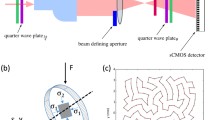Abstract
A new technique for simultaneous determination of both fringe order and principal direction of birefringence in practical photoviscoelastic analysis using white incident light with a set of the primary colors, called tricolor photoviscoelasticity, is described. This method can determine both the fringe order and principal direction of birefringence from a single-color photoviscoelastic image under plane polarization. Then, the authors evaluate time dependent stresses and strains around a contact region in a viscoelastic strip plate under nonproportional loading condition. The variations of the principal stresses and strains are easily obtained over a wide time range by use of the optical constitutive equations of photoviscoelasticity and the characteristic material property functions.
Similar content being viewed by others
References
Johnson, K.L., Contact Mechanics, Cambridge University Press, Cambridge (1985).
Lee, E.H. andRadok, J.R.M., “The Contact Problem for Viscoelastic Bodies,”Trans. ASME, Ser. E, J. Appl. Mech.,27,438–444 (1960).
Ting, T.C.T., “Contact Problems in the Linear Theory of Viscoelasticity,”Trans. ASME, Ser. E, J. Appl. Mech.,35,248–254 (1968).
Chen, W.H., Chang, C.M., andYeh, J.T., “An Incremental Relaxation Finite Element Analysis of Viscoelastic Problems with Contact and Friction,”Computer Meth. Appl. Mech. Eng.,109,315–329 (1993).
Raous, M., Chabrand, P., andLebon, F., “Numerical Methods for Frictional Contact Problems and Applications,”J. Theoretical Appl. Mech.,7,111–128 (1988).
Kunio, T., Miyano, Y., andSugimori, S., “Fundamentals of Photoviscoelastic Technique for Analysis of Time and Temperature Dependent Stress and Strain,”Applied Stress Analysis, ed. T.H. Hyde andE. Ollerton, Elsevier Applied Science, London, 588–597 (1990).
Gotoh, J., Horie, H., Misawa, A., and Takashi, M., “Photoviscoelastic Method for Time Dependent Stress and Strain Analysis Under Nonproportional Loading,” Proc. SEM Spring Conf. on Exp. Mech., Grand Rapids, MI, 234–241 (1995).
Voloshin, A.S. andBurger, C.P., “Half-fringe Photoelasticity: A New Approach to Whole-field Stress Analysis,” EXPERIMENTAL MECHANICS,23,304–313 (1983).
Patterson, E.A. andWang, Z.F., “Towards Full Field Automated Photoelastic Analysis of Complex Components,”Strain,27,49–56 (1991).
Morimoto, Y., Morimoto, Y., Jr., andHayashi, T., “Separation of Isochromatics and Isoclinics Using Fourier Transform,”Exp. Tech.,18 (5),13–17 (1994).
Umezaki, E., Watanabe, H., and Shimamoto, A., “Automatic Whole-field Measurement of Photoelastic Fringe Orders Using Generalized Phaseshift Method,” Post Conf. Proc. VIII Int. Cong. on Exp. Mech., 154–159 (1996).
Redner, A.S., “Photoelastic Measurements by Means of Computer-assisted Spectral-content Analysis,” EXPERIMENTAL MECHANICS,25,148–153 (1985).
Haake, S.J. andPatterson, E.A., “Photoelastic Analysis of Frozen Stressed Specimens Using Spectral-contents Analysis,” EXPERIMENTAL MECHANICS,32,266–272 (1992).
Ajovalasit, A., Barone, S., andPerucci, G., “Towards RGB Photoelasticity: Full-field Automated Photoelasticity in White Light,” EXPERIMENTAL MECHANICS,35,193–200 (1995).
Hoy, D.P.E. and Zhao, W., “Color Digital Imaging System for White-light Isoclinic Analysis,” Post Conf. Proc. VIII Int. Cong. on Exp. Mech., 13–17 (1996).
Gotoh, J., Yoneyama, S., Mawatari, S., and Takashi, M., “Photoelastic Analysis from a Single Piece of Image with Linearly Polarized RGB Lights,” Post Conf. Proc. VIII Int. Cong. on Exp. Mech., 160–166 (1996).
Yoneyama, S., Takashi, M., andGotoh, J., “Time- and Temperature-dependent Stress-strain Analysis Using White Light Photoviscoelasticity,”Proc. SPIE,2921,486–491 (1997).
Yoneyama, S., Gotoh, J., and Takashi, M., “Photoelastic Analysis from Single Image with the Three Primary Colors,” Proc. Int. Conf. on Advanced Technology in Exp. Mech., Wakayama, 429–434 (1997).
Yoneyama, S., Shimizu, M., Gotoh, J., and Takashi, M., “Photoelastic Analysis with a Single Tricolor Image,” Opt. Larser, Eng., forthcoming.
Pindera, J.T. andCloud, G., “On Dispersion of Birefringence of Photoelastic Materials,” EXPERIMENTAL MECHANICS,6,470–480 (1966).
Ishida, K. andYoshimoto, F., Spline Functions and Its Application, Kyoiku Shuppan, Tokyo (1979)(in Japanese).
Williams, M.L., Landel, R.F., andFerry, J.D., “The Temperature Dependence of Relaxation Mechanics in Amorphous Polymers and Other Glass-forming Liquids,”J. Am. Chem. Soc.,77,3701–3707 (1955).
Author information
Authors and Affiliations
Rights and permissions
About this article
Cite this article
Yoneyama, S., Gotoh, J. & Takashi, M. Tricolor photoviscoelastic technique and its application to moving contact. Experimental Mechanics 38, 211–217 (1998). https://doi.org/10.1007/BF02325745
Received:
Revised:
Issue Date:
DOI: https://doi.org/10.1007/BF02325745



